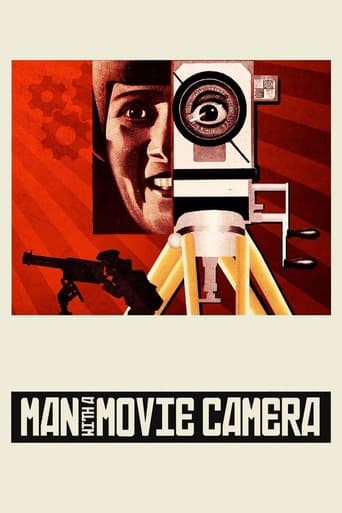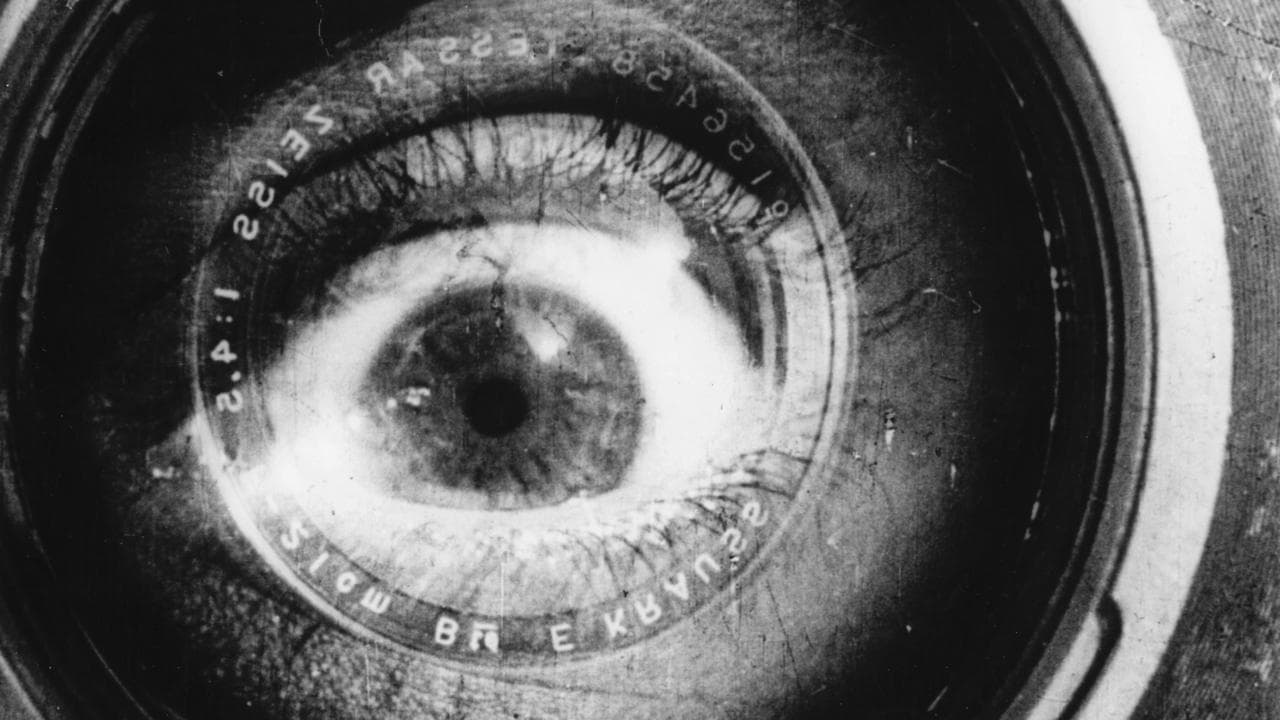rzajac
All you really need to "know" (as it were) is that after watching Man with a Movie Camera, you can't escape the impression that Koyaanisqatsi had to have essentially been a remake.The following things come so close as to drive home such a conclusion: It's a frenetic, gushing, pouring-forth hash of largely fleeting images. The images are mostly of urban artifacts. And the music seems to have been written by a guy under the auspices of, really, the exact same muse as Philip Glass.And the funny part is... there's almost nothing else to say! If you, um, "enjoyed" Koyaanisqatsi--OK: maybe "respected" is a better word--you should try out this flick to see if it rustles up the same degree of respect. It did for me! I could have turned if off at any time, and I was riveted by the artful barrage of urban existence imagery.
ironhorse_iv
Sometimes called 'A Man with a Movie Camera', 'The Man with the Movie Camera', 'The Man with a Camera', 'The Man with the Kino-camera', or 'Living Russia'. This experimental, avante-garde film is indeed, a confusing masterpiece. Driven by the vision that cameras are supposed to show a deeper truth which could not be seen with the naked eye; Soviet writer/director Dziga Vertov AKA David or Denis Kaufman did all this, in an attempt for film truth AKA Kino-Pravda. Shot with a camera, over the course of three years in the towns of Moscow, Kiev, Kharkov and Odessa; the movie tells the story of a filmmaker (Dziga Vertov) traveling around a Soviet city with a camera slung over his shoulder, documenting urban life. Using a radical use of montage and other inventive editing techniques, such as jump cuts, close ups, split-screen, Dutch angles, hand-held, tracking shot, dissolves, over-lane, double exposure, fast and slow motion, Dziga Vertov is able to show an excellent example of an "industrial city symphony travelogue" newsreel. Man with a Camera really does show the film truth. It pretty much influence the Cinéma vérité style in France. Because of that, there is no other silent film like this, at the time. It remind me of the silent era version of 1982's 'Koyaanisqatsi' or 1992's 'Baraka', because it has no overall narrating, actors or dialogue (In this case, much intertitles). I also love how the movie explain, how movies are made. It really expose the business, in which, they make their money. The movie even freeze frame, toward the middle to show us, the viewers, how this movie was getting edited by his wife Elizaveta Svilova. It was great insight at the time. Let's remember, there wasn't a behind the scenes or making of a film, documentary back then. So, pretty much, this was your inside look at the business, besides joining Hollywood, or going to filmmaking school. This part of the film is the reason, why I wanted to see it. The way, they film things, is interesting to me. One good example is the oncoming train scene. It was intense. Showing how they pull it off, was amazing. Probably, the best part of the scene. Another is the superimposing shot of the cameraman setting up his camera atop a big mountainous camera. Even, the shot with the cameraman inside a beer glass was cool. It emphasizes that film can indeed do anything, and go anywhere. It was so surreal. Even with those dream-like staging sequences, most of the film is a series of newsreels of real-life actualities. While, the birth and death scene is kinda graphic. Its show, how real, this movie is. The movie is also pretty political with industrial driven message. The first shot of the city, is a couple of questionable bums sleeping on a bench. It's then show a woman engaging in target practice, intercut with a box of champagne bottles, which disappear one at a time, as if she is shooting them. Then, you see shots of showing the healthy frivolous or leisure activities with that of strong industrial workers. It shows the communism new belief of rational recreation and how it's better for people to have leisure more controlled, ordered, and improving as a team, rather than the belief that one has success through self-improvement and self-enrichment. It's clearly, a shot at capitalism beliefs by then-Leninism style beliefs. A man getting a shave is intercut with an axe being sharpened, show how metaphoric, this film can be, for the people. Not everything in this movie is intense, dark & political. There were some funny moments, such as a couple applying for a marriage license, being followed shortly afterward by another couple applying for a divorce. It even got sexy and romantic at times, with a woman getting out of bed and getting dressed. Follow by a date with a couple, then marriage. However, some of the others visuals in this film, is a little too weird, like the crawfish on a plate at a seafood restaurant is made to appear to crawl away or the shots of chess pieces being swept to the center of the board to understand the meaning. I don't know, how those visuals is supposed to help the message of the contemporary "man" evolve from a flawed creature into a higher, more precise form at all. Overall: While, some of the visuals in this film is too strange for the general viewers and too stage for documentary lovers. It's still a well made movie, worth seeing. So check it out if you get the time.
De_Sam
Vertov utilises the whole array of available camera and montage techniques to portray a normal day in Russia, while also showing how it is made; fast motion, slow motion, stop-motion, freeze-frame, thawed-frame, playing film backwards, double exposure, etc. A part of the film comes over as a documentary of how a film is made, namely the balance of focus and the daring stunts of early cameramen.What is being filmed is typical for the 'agitprop', i.e. everyday life of the proletariat, here sometimes put in contrast with the lavish lifestyle of the bourgeoisie. Vertov put some dialectical elements in the montage, most notably the diagonals in the earlier parts of the film, other times he draws parallels, e.g. between the working class and the cameraman/director (in my opinion Vertov did this to assert he and other filmmakers belonged to the same group) or between the washing of a woman and the washing of the city.Other communist elements are also present, the one that stood out the most was the glorifying of machines and the relation between man and machine (the total opposite of Japanese New-wave). For the most part the film escapes explicit propaganda, mostly due to the non-narrative form (it is easy to see why Stalin stopped this kind of cinema, as propaganda it did not work for many did not understand the meaning behind the dialectic montage). I needed to acclimate to the normal way of viewing movement after the film had ended, being made strangely aware of the similarities and differences between my eyes and the 'eye' of the camera. It had an hypnotic, psychedelic effect.To conclude, I would recommend this film, but only to those who have some background information on the Russian constructivism, as otherwise this could come over as too nonsensical and pointless (like all those purely structuralist films, e.g. Wavelength).
kurosawakira
I wrote this in April 2012, and still subscribe to every word.Having never seen this before, I was expecting something that after 80 years would seem piffling, banal, trashy and insipid. Instead, I saw a film full of so many visual ideas I'm still in awe, presenting the one idea I personally think is the most important one in film.I don't like to think of this as a film as much as a notebook or canvas of ideas. Together they don't really seem to work that well, but individually they're earth-shattering and have been used later to great effect. Sure, the presentation is a bit too explanatory for my taste when it comes to the metaphors, but that's what 80 years does.What is that one image, then? Unfortunately it's repeated a bit too often to benumb its potential, but it's the earliest effective use of it that I've seen — it's the iconic image of the reflection of a human eye in the lens. That image, for me, tells what film is all about in the end: the camera is the eye that not only perceives but creates. It might sound simple nowadays, and certainly wasn't obscure even back then, but it's such a transparent and elegant statement – save the repetition – that I will always carry it with me.


 AD
AD



